

| Wendy Wishert and Katie Lyssy | Fall 2000 |
| History 1301 | Hines |
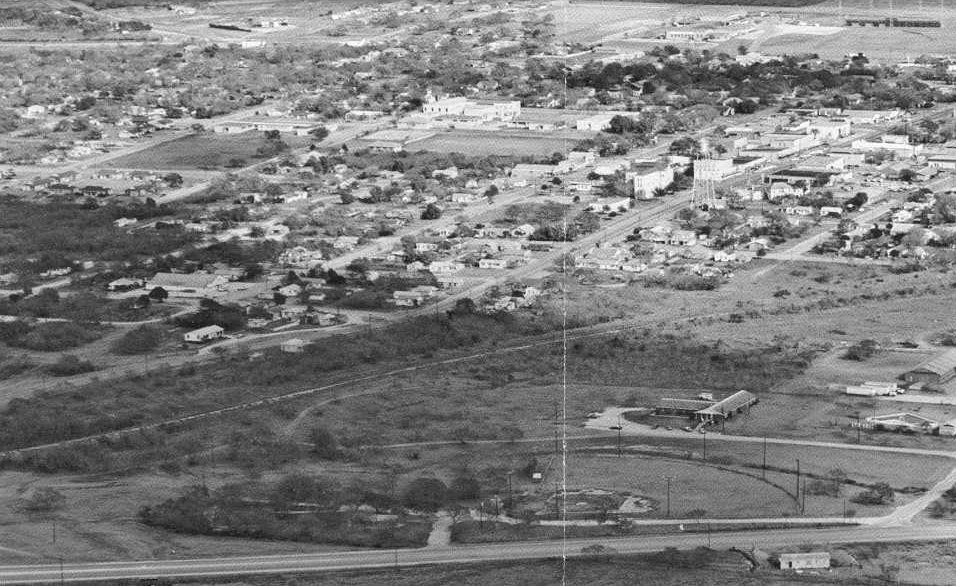 If you have ever wanted to go to a south Texas town with a lot of history and nice people, Karnes City may be just the town that you are looking for. It is located on Highway 181 about half way between Corpus Christi and San Antonio.
If you have ever wanted to go to a south Texas town with a lot of history and nice people, Karnes City may be just the town that you are looking for. It is located on Highway 181 about half way between Corpus Christi and San Antonio.
 ORIGINS: Karnes City was founded in 1890 during the Christmas season when a group of Cuero businessmen bought 1,000 acres of land from J. L. Calvert for $5 an acre. In 1891, the land was surveyed and laid off into lots and blocks. It was named for Henry Wax Karnes, a dedicated war-hero and Texas Ranger, who died at the age of 28, after contracting yellow fever. The first Post Office was established on April 1, 1891, and because of the similarities between Karnes and Kernes, another Texas town, city was added to the name, making it Karnes City.
ORIGINS: Karnes City was founded in 1890 during the Christmas season when a group of Cuero businessmen bought 1,000 acres of land from J. L. Calvert for $5 an acre. In 1891, the land was surveyed and laid off into lots and blocks. It was named for Henry Wax Karnes, a dedicated war-hero and Texas Ranger, who died at the age of 28, after contracting yellow fever. The first Post Office was established on April 1, 1891, and because of the similarities between Karnes and Kernes, another Texas town, city was added to the name, making it Karnes City.
 The first school was completed on October of 1891, and was used for school during the weekdays, a dance hall at night, and for Sunday School and church on Sundays. The San Antonio and Aransas Pass Railroad added a side track where lumber for new homes and businesses could be unloaded when it became apparent that the new town would grow. Some of the first early businesses included a saloon, a lumberyard, a livery stable, and a drugstore. The first church was the Karnes City Methodist Episcopal Church, established in 1893.
The first school was completed on October of 1891, and was used for school during the weekdays, a dance hall at night, and for Sunday School and church on Sundays. The San Antonio and Aransas Pass Railroad added a side track where lumber for new homes and businesses could be unloaded when it became apparent that the new town would grow. Some of the first early businesses included a saloon, a lumberyard, a livery stable, and a drugstore. The first church was the Karnes City Methodist Episcopal Church, established in 1893.
HISTORICALLY SIGNIFICANT STORIES: The first legend has to do with Karnes City becoming the county seat. By 1893, Karnes City was the largest city in the county and citizens petitioned to move the county seat from Helena to Karnes City. An election was held, and the voters favored Karnes City 2 to 1. On January 4, 1894, the court ordered advertisements for plans and specifications for a new courthouse and jail. In the meantime, a temporary jail and county offices were built. Helena, however, refused to give up the county seat. Legend has it that a band of Karnes City men, on 20 horse-drawn wagons, went to Helena during the night to take the official county records. Helena authorities had posted an armed guard at their courts to protect the county property, but had forgotten to tell him to shoot at anyone who tried to take it. The guard climbed aboard one of the wagons and "protected" the property until it reached Karnes City.
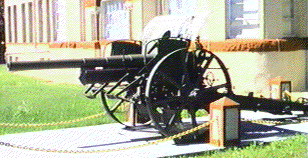
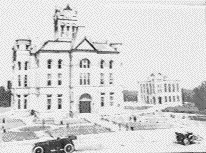 |
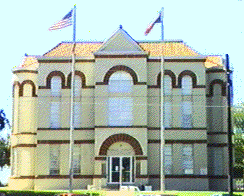 |
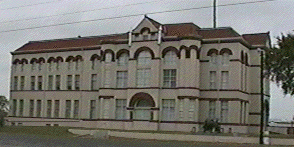 |
| Karnes County Courthouse | ||
LANDMARKS: The biggest landmark in Karnes City is the Court House. In 1894, the building contract was awarded to John Carmack for the sum of $43,000 for plans to build a three-story brick courthouse. Construction of the building was completed in 1895 and a jail was also added. Since the construction of the courthouse and jail, the courthouse has been remodeled twice and the original jail was torn down in 1957, making room for a more modern jail.
Another landmark is historic downtown Karnes City. The picture below shows what it looked like in the 1930s. For the most part it looks the same with new and different businesses.
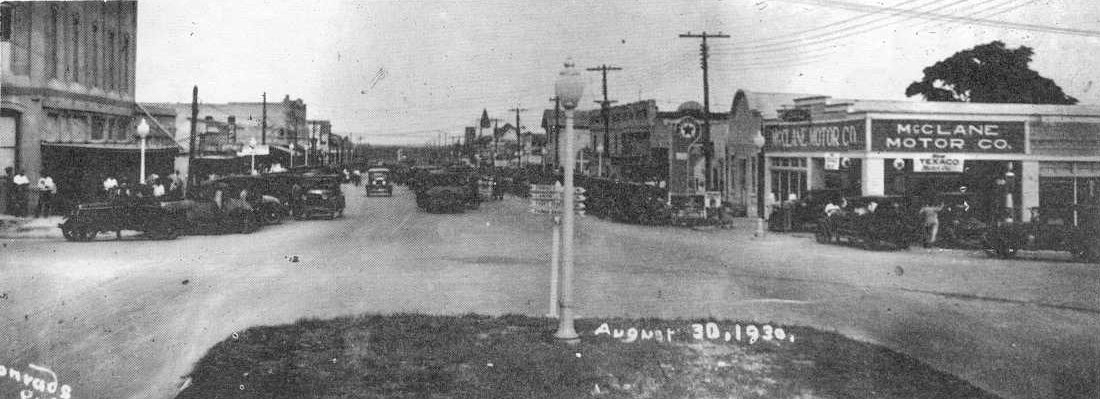
INTERVIEWS: The first interview is of Lyman B. Russel. She remembers moving from Goliad to Karnes City in a wagon pulled by oxen. Back then four pounds of sugar cost one dollar, four pounds of coffee cost one dollar, and one quart of whiskey cost twenty-five cents. Salt was very scarce in the South, and they used mesquite wood for cooking and heating. During most of the decade of the 1920's the passenger train ran twice each day from each direction, with one or more freights each day.
The second interview is of Rudolph Faith. He moved to Karnes City in November of 1914, and lived in a rented apartment on the main business street between Karnes Mercantile and the corner occupied by McClane Motor Company. The courthouse and the railroad were the only industries, and cotton was the only cash crop. None of the streets were paved before 1930 except the main business street from San Antonio to Corpus Christi. There were no water systems in the town, most families used cisterns. The speed limit on the main highway was 20 miles per hour.
 Mr. Faith's class was the first to complete four years in the new school system. The school also held plays for an admission price of .15 to .25 cents. The only sports that girls could play was a basketball game on the dirt. The boys were offered basketball on a dirt ground, track and field, and tennis. The athletes were called Badgers for as long as he can remember.
Mr. Faith's class was the first to complete four years in the new school system. The school also held plays for an admission price of .15 to .25 cents. The only sports that girls could play was a basketball game on the dirt. The boys were offered basketball on a dirt ground, track and field, and tennis. The athletes were called Badgers for as long as he can remember.
ECONOMY: During the railroad boom, six passenger trains a day came through town. The economy was based on ranching, farming, uranium, oil, and gas. In 1926, the Karnes City Chamber of Commerce was organized. There were also a number of civic and fraternal organizations that became active during the 1900s.
Since then, the city has had its own hospital and movie theater (both have closed), hundred of businesses, at least 12 churches, new schools, four banks, and many more civic, fraternal, and patriotic organizations. The population has steadily risen to almost 4,000 people. Today the economy is based on farming, ranching, related agribusiness, fiberglass and steel products, oil and gas production, uranium mining and milling, and jobs working at the new prison.
CONCLUSION: In conclusion, Karnes City is a town with lots of historical value and interesting stories. If you want to know more local stories and meet some of the friendly locals, you should jump in your car and drive down Highway 181 and experience Karnes City for yourself.
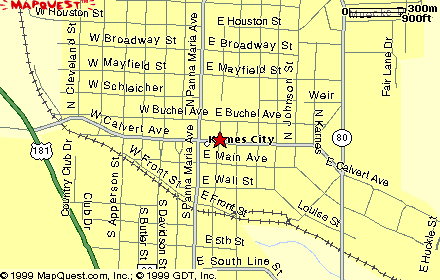
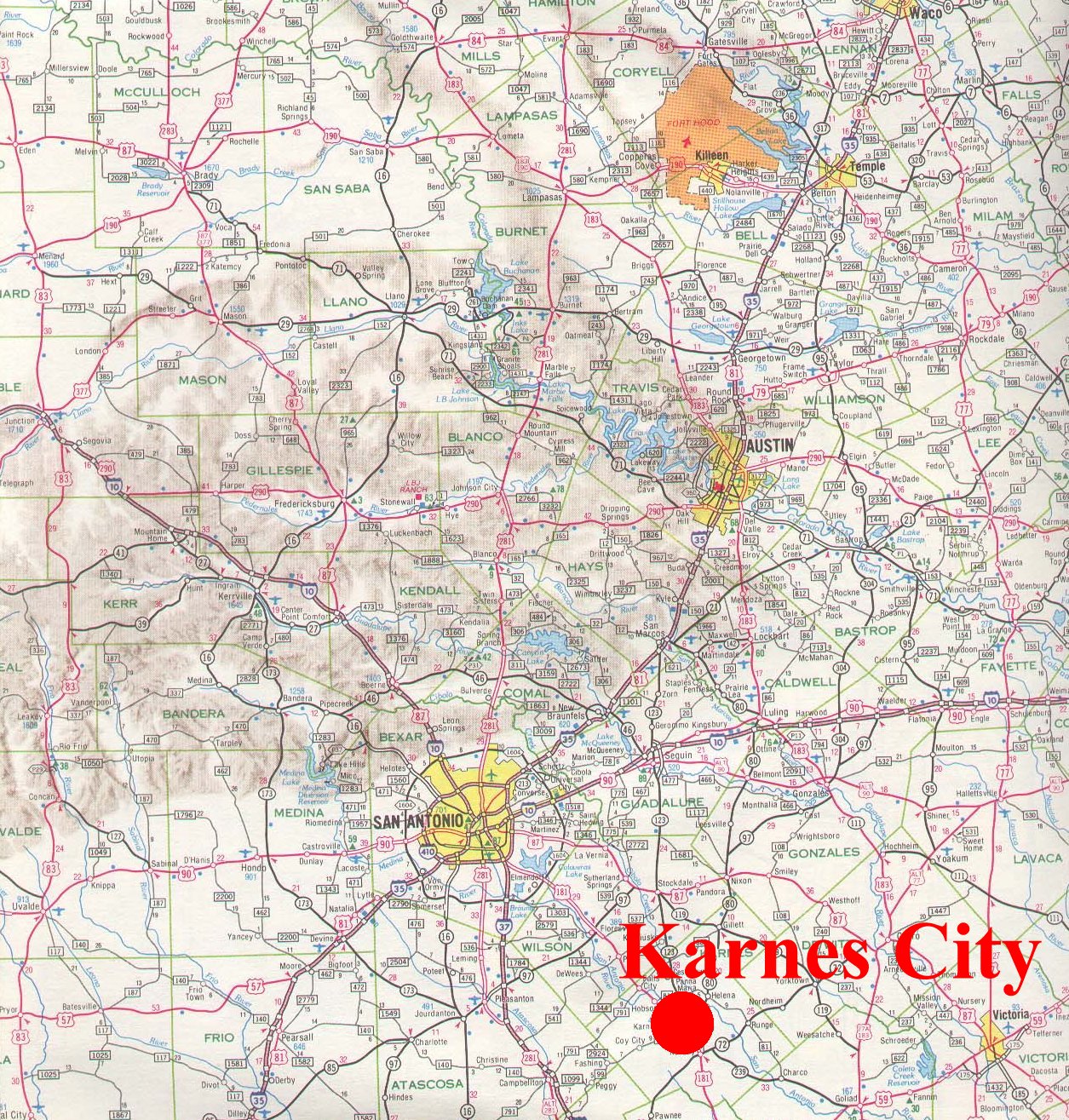
Anderson, R.J. "CPL...Progress For Karnes City," The Kenedy Times (September 15, 1963), p. 5.
We used this newspaper source for it's information on the progress that took place to make Karnes City what it is today. This was a good source because it told us how rapidly things were changed and how Karnes City used it's technology. We would have liked to have read a little more about how this affected the public though.
Baker, Carlos. "Facts about Karnes City Schools," The Kenedy Times (October 31, 1963), p. 1.
We used this newspaper source for it's information on Karnes City's schools, it also gave us a nice picture of the school, which we used for the web-site. This was a good source because it had a very detailed article, and was very easy to understand. We can not think of anything that they left out, this was one of the best sources we used for this topic.
Didear, Hedwig Krell. A History of Karnes County And Old Helena. Austin: Jenkins Publishing Company, 1969.
We used this book source for it's information on the style of life people had to live and the basic living facilities of the community. This was a good source because it not only talked about the wealthy, but talked about all groups of people and their different ways of living. We would have liked to know more detail of some of these ideas though, some facts left very little information to go on.
Faith, Rudolph. Interview by John Barnet. Karnes City, Texas, 1983.
We used this interview to find out how people lived back then, and how they saw life in their lives. We liked this source because it gave us a good idea about how people actually lived, and let us know a little bit more about the lifestyle of our relatives living back then. We would have liked to found out more of the activities they did back then for fun, so that we could compare them to today.
Johnson, Janet. "The History of the Karnes City Courthouse." Helena Courthouses. (February 1, 1996) 2pp. October 18, 2000.
This site was very useful to us in finding out information about the courthouse in Karnes City. We liked this source because it gave us straight facts that were very useful and important. We would have liked to see more pictures of the previous courthouses in this source though.
Karnes City "Growing With South Texas". Karnes City: Chamber of Commerce of the United States, Commerce Department, 1951.
This source was very useful because it gave us a variety of pictures of buildings, livestock, and more with information to explain the pictures. We liked this source because it gave us good pictures so that we could tie all of our information together. We wish it would have given us a few churches with detailed information though.
Karnes City Quality Builds Quantity. Karnes City, Community: Chamber of Commerce of the United States, Commerce Department, 1996.
This source gave us a very nice picture of Karnes City's whole view. We liked this because it gave us the idea of how everything was ran, and also gave us a good picture to use for the web-site. This source did not give much written information though, and we wished it would have.
Russell, Lyman B. Interview by E.P. Ruhmann. Karnes County, Texas, 1965.
This interview gave us a second view on the way of living in Karnes City. We liked this interview because we could compare it to our first interview. We wish it would have given a lot more information though, and would have talked more about the individuals life, and not so much the surrounding town.
Simmons, Dorothy. Hearth, Home and Heritage. Dallas, Texas: Taylor Publishing Company, 1993.
This source gave us good sketches, and good information backing these sketches. We liked this source because it was very easy to understand and did not clutter it's information. We wish it would have had a little more information on Karnes City though.
Thonhoff, Robert H. "History of Karnes County." Karnes County Contennial. (February 15, 1999) 3pp. On- line. Internet. October 17, 2000.
We used this source to find a general look at Karnes City's history. We liked this source because it stated only the important facts that the town is known for. We had hoped it would have told the information with a little more detail though.